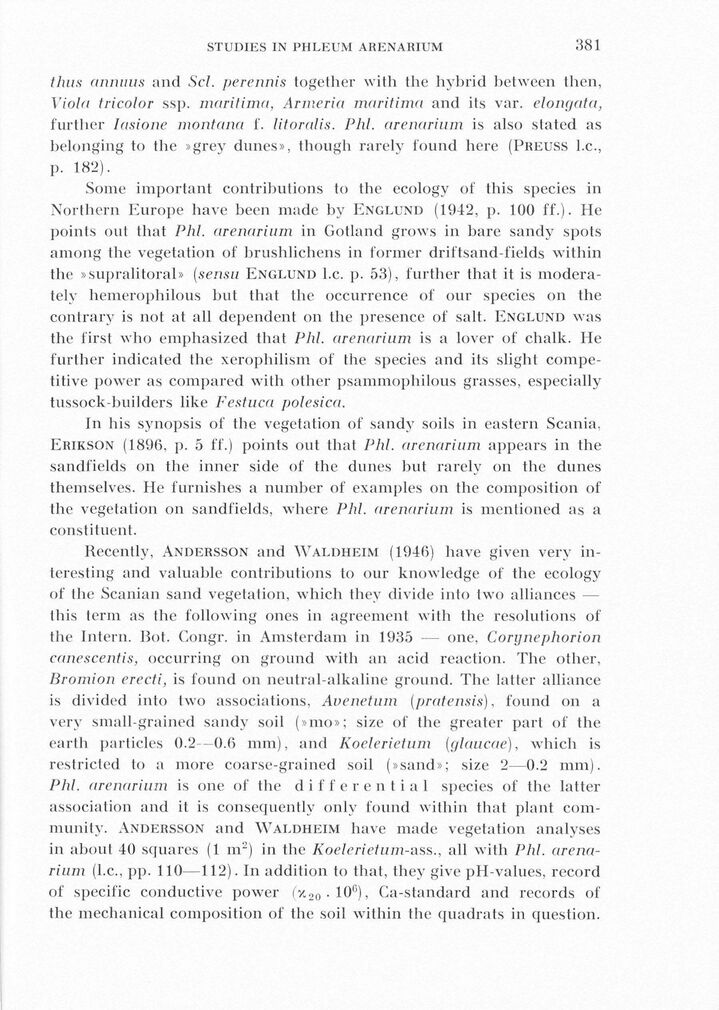
Full resolution (JPEG) - On this page / på denna sida - Sidor ...

<< prev. page << föreg. sida << >> nästa sida >> next page >>
Below is the raw OCR text
from the above scanned image.
Do you see an error? Proofread the page now!
Här nedan syns maskintolkade texten från faksimilbilden ovan.
Ser du något fel? Korrekturläs sidan nu!
This page has never been proofread. / Denna sida har aldrig korrekturlästs.
STUDIES IN PH LE UM ARENARIUM
381
t hus aniuius and Sel. perennis together with the hybrid between then,
Viola tricolor ssp. maritima, Armeria maritima and its var. elongata,
further Iasione montana f. litoralis. Phl. arenarium is also stated as
belonging to the »grey du nes», though rarely found here (Preuss I.e.,
p. 182).
Some important contributions to the ecology of this species in
Northern Europé have been made bv Englund (1942, p. 100 ff.). He
poin|s out that Phl. arenarium in Gotland grows in bare sandy spöts
among the vegetation of brushlichens in former driftsand-fields within
the »supralitoral» (sensu Englund I.e. p. 53), further that it is
modera-tely hemerophilous hut that the occurrence of our species ön the
contrary is not at all dependent ön the presence of salt. Englund was
the first who emphasized that Phl. arenarium is a lover of chalk. He
furlher indicated the xeropliilism of the species and its slight
compe-titive power as compared with other psammophilous grasses, especially
tussock builders like Festuca polesica.
In Iiis synopsis of the vegetation of sandy soils in eastern Scania,
Erikson (1896. p. 5 ff.) points out that Phl. arenarium appears in the
sandfields ön the inner side of the dunes but rarely ön the dunes
themselves. He furnishes a number of examples ön the composition of
the vegetation ön sandfields, where Phl. arenarium is mentioned as a
constituent.
Recently, Andersson and Waldheim (1946) have given very
in-teresting and valuable contributions to our knowledge of the ecology
of the Scanian sand vegetation, which they divide iniö two alliances —
this term as the following ones in agreement with the resolutions of
the Intern. Bot. Congr. in Amsterdam in 1935 — one, Corynephorion
canescentis, occurring ön ground with an acid reaction. The other,
Bromion erecti, is found ön neutral-alkaline ground. The latter alliance
is divided into two associations, Avenetum (pratensis), found ön a
very small-grained sandy soil (»mo»; size of the greater part of the
earth particles 0.2 -0.6 mm), and Koelerietum (glaucae), which is
restricted to a möre coarse-grained soil (»sand»; size 2—0.2 mm).
Phl. arenarium is one of the differential species of the latter
association and it is consequently onlv found within that plant
Community. Andersson and Waldheim have made vegetation analvses
in about 40 squares (1 m2) in the Koelerietum-ass., all with Phl.
arenarium (I.e., pp. 110—112). In addition to that, they give pH-values, record
of specific conductive power (x2O.10G), Ca-standard and records of
the mechanical composition of the soil within the quadrats in question.
<< prev. page << föreg. sida << >> nästa sida >> next page >>